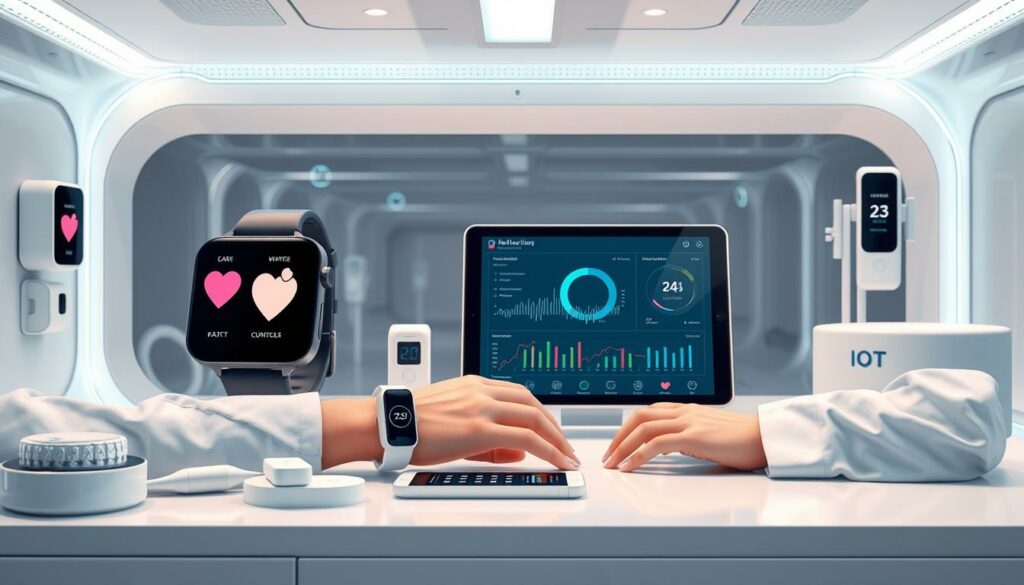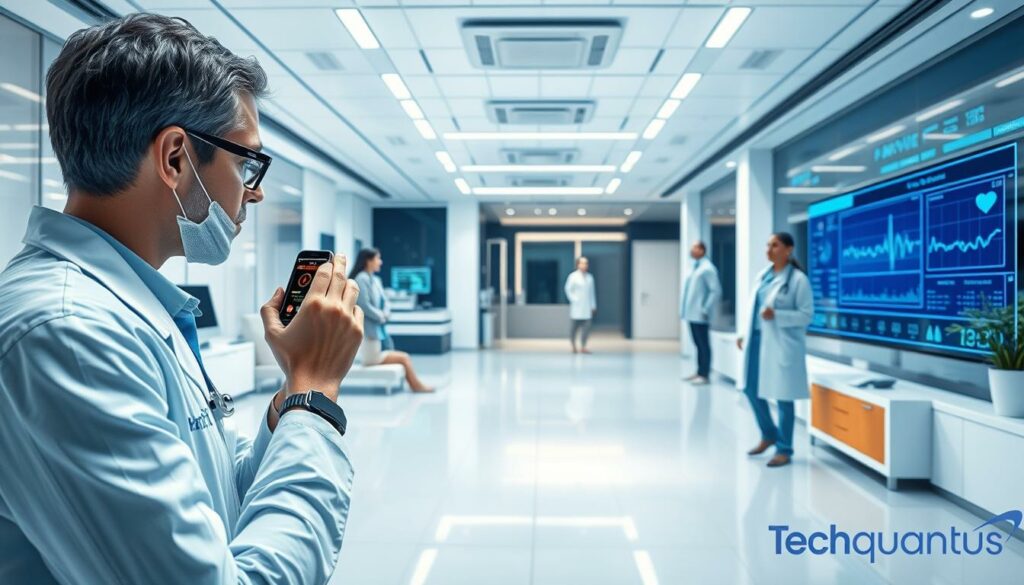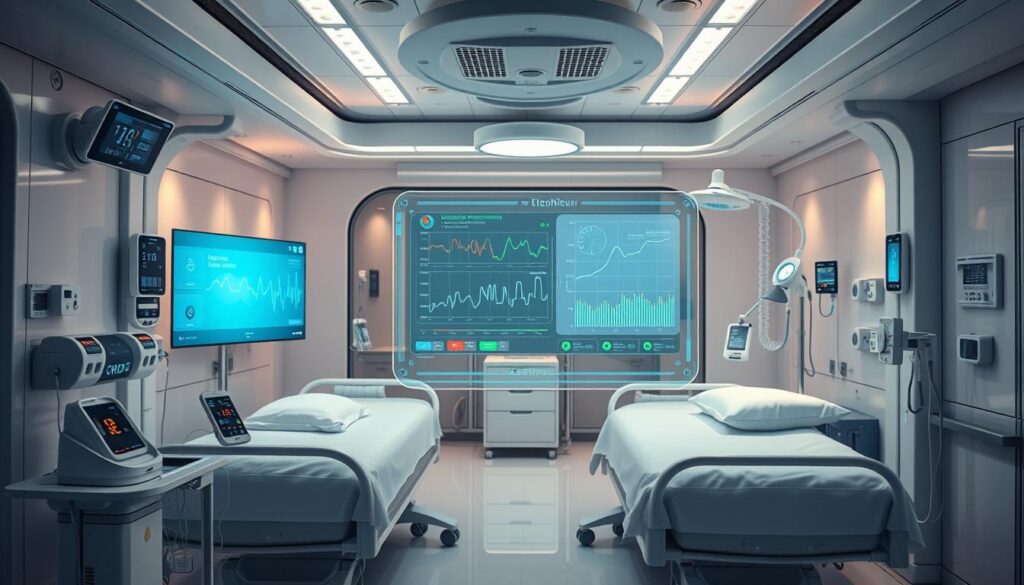Did you know the global market for remote patient monitoring with IoT is set to hit $1.7 billion by 2025? This shows how vital IoT is in healthcare, especially with the recent health challenges. IoT is key for remote patient monitoring, offering continuous tracking and real-time data sharing.
To use IoT in healthcare well, you must know its technical aspects and how it fits with healthcare goals. The goal is to improve patient care and use resources wisely. IoT healthcare solutions create a system that focuses on patient health and encourages early health actions.
We’ll look at IoT’s role in healthcare, its benefits, choosing devices, keeping data safe, and adding IoT to telemedicine. You’ll learn how to overcome challenges and use health data to improve patient care.
Key Takeaways
- Understanding the growing market for IoT in healthcare is essential for effective implementation.
- Remote patient monitoring allows for continuous health tracking and real-time data sharing.
- Aligning IoT technologies with healthcare goals can significantly enhance patient outcomes.
- Selecting the right IoT devices is critical in maximizing healthcare benefits.
- Data security and privacy must be prioritized while implementing IoT solutions.
- Integrating IoT devices with telemedicine enhances patient engagement and care.
- Leveraging data analytics can lead to better patient insights and treatment outcomes.
Introduction to Remote Patient Monitoring
Remote Patient Monitoring (RPM) is a new way in healthcare. It lets doctors keep an eye on patients outside of hospitals. This method uses technology to collect health data, cutting down on the need for many visits.
It helps manage chronic conditions and keeps patients more involved in their care. With telemedicine, RPM makes it easier for patients to take part in managing their health. By using connected devices, you can get real-time health data. This helps doctors make better decisions.
The healthcare world is changing fast, and IoT healthcare is leading the way in patient care. These new technologies help doctors give care that fits each patient’s needs. RPM is getting better, leading to better health outcomes and happier patients.
For more info on the future of IoT security, check out IoT security challenges. Knowing about these issues helps you plan your RPM better, meeting what the industry expects.
Understanding the Role of IoT in Healthcare
IoT in Healthcare is changing how we manage patient care. It connects healthcare tech with what patients need. Wearable monitors and smart apps track health metrics in real-time.
This lets doctors make quick decisions and act fast when needed.
Wearable tech is big for health lovers. Smartwatches track heart rates, activity, and sleep. This info helps patients and doctors tackle health issues early.
Each alert from these devices is key. Systems handle up to six notifications. This keeps you updated on your health.
Smart home health tech shows IoT’s impact in healthcare. Devices manage meds or track chronic conditions. They give you feedback and reminders. You can get one custom notification, making health care fit your life.
IoT does more than help individuals. Hospitals see better patient outcomes with better monitoring. IoT has cut hospital readmissions by a lot. This shows how big an impact these technologies have.
As more patients and doctors use IoT, healthcare gets better. For more on AI in healthcare, check out this resource. IoT’s role will keep growing, offering new solutions for patients and doctors.
Benefits of IoT Technologies for Remote Patient Monitoring
Using IoT in remote patient monitoring has many benefits. It makes healthcare better. It gives accurate real-time data, which helps doctors and nurses take quick action.
It also means patients and doctors can easily share important health info. This helps make better decisions and stop problems before they start.
IoT devices help keep patients out of the hospital. They send alerts when health issues arise. This leads to early action, not just reacting after things get worse.
| Benefit | Description |
|---|---|
| Real-time Monitoring | Allows healthcare professionals to monitor patients continuously, ensuring immediate responses to health issues. |
| Personalized Care | Facilitates customized treatment plans based on individual patient data, improving overall care quality. |
| Health Data Access | Provides instant access to crucial health metrics for patients and providers, enhancing decision-making. |
| Emergency Response | Improves emergency response times due to real-time alerts and data collection. |
| Reduced Readmissions | Minimizes the likelihood of readmission through consistent monitoring and early intervention. |
These technologies improve care quality and show the benefits of IoT healthcare. They make healthcare more efficient. By looking into IoT, we can see how it helps with remote patient monitoring.
Choosing the Right IoT Devices
Choosing the right IoT devices for healthcare is key for remote patient monitoring. You need to look at several factors when picking devices. This ensures the best results for your patients and healthcare systems. Important things to consider include how well they work with current health systems, how easy they are to use, their reliability, and if they follow the rules. Also, how comfortable patients feel about sharing their data greatly affects their choice of devices.

- Wearable fitness trackers
- Glucose monitors
- Vital sign monitors
- Connected health applications
Here’s a comparison of different IoT devices based on important features:
| Device Type | Key Features | Average Cost | Patient Satisfaction (%) | Impact on Readmissions (%) |
|---|---|---|---|---|
| Wearable Fitness Trackers | Heart rate, activity levels | $50 – $300 | 85 | -10 |
| Glucose Monitors | Continuous glucose monitoring | $70 – $400 | 90 | -15 |
| Vital Sign Monitors | Blood pressure, heart rate | $100 – $500 | 88 | -20 |
| Connected Health Applications | Data tracking, alerts | $10 – $100 (subscription) | 82 | -12 |
By choosing devices wisely, you can make connected health solutions work better. This leads to better patient outcomes and uses IoT devices fully in healthcare. Focus on devices that fit your healthcare plan and meet the needs of both providers and patients.
Data Security and Privacy Considerations
The rise of IoT in healthcare raises big concerns about data security and privacy. Making sure data security in healthcare is key as more sensitive patient info is sent out. A survey found 78% of healthcare workers worry about data breaches, showing the need for strong security steps.
IoT healthcare security is key to keeping patient data safe. Research shows 64% of patients worry about the safety of their medical data with IoT devices for remote checks. This shows how important it is for healthcare groups to focus on cybersecurity and protect sensitive info well.
Healthcare has faced many cyberattack challenges. 82% of these groups said they’ve seen attacks on patient data in the IoT world. This shows how vital strong security steps are, like encryption, to keep IoT device data safe. Sadly, only 37% of healthcare providers use strong encryption to protect patient info.
IoT devices are also a big worry. 45% of them for remote patient checks don’t have basic security, making them easy targets for hackers. An analysis found 55% of breaches came from unauthorized access to these devices. With IoT device breaches in healthcare going up by 300% in two years, we really need better privacy considerations.
For those interested in the history of tolerance in liberal democracies, check out forms of secularity in the Arabic. It’s related to privacy issues in healthcare advancements.
| Data Security Concerns | Statistics |
|---|---|
| Healthcare professionals worried about data breaches | 78% |
| Patients concerned about medical data security | 64% |
| Healthcare organizations facing cyberattacks | 82% |
| Increase in IoT-related healthcare data breaches | 300% |
| Healthcare providers with robust encryption protocols | 37% |
| IoT devices lacking basic security features | 45% |
| Breaches caused by unauthorized access to IoT devices | 55% |
Integrating IoT Devices with Telemedicine IoT Devices
Combining IoT devices with telemedicine improves healthcare. It makes sure patients and doctors can talk in real-time. This is key for telehealth, giving quick access to data from IoT devices.
The Smart Healthcare Market is growing by 5.00%. New tech is pushing this growth. Integrating IoT with telemedicine is vital for patient care. The market offers many options to improve healthcare.
Healthcare providers should use IoT devices that work well with telehealth. This makes care better by using real-time data. It helps make treatment plans more effective.
Companies like Siemens Medical Solutions and IBM are leading in smart healthcare. They bring new tech to telemedicine, focusing on patient care and satisfaction.
Using data from IoT devices is important for making medical decisions. These devices help keep track of patient health. They make healthcare more responsive.

Understanding market trends is crucial in this changing field. Check out here for more on the trends in smart healthcare. This keeps your knowledge up-to-date with the latest developments.
Leveraging Health Data Analytics for Improved Patient Outcomes
Health data analytics is key to better patient care by making sense of IoT device data. It helps spot trends and risks by looking at patient data. This way, healthcare providers can make smart decisions.
Tools like machine learning and statistical modeling help make these decisions. They let doctors create care plans that fit each patient’s needs. This means care is based on solid evidence, making remote patient monitoring more effective.
Combining health data analytics with IoT tech changes how we care for patients. For more details, check out this link for how these technologies work together in real life.
| Method | Description | Impact on Patient Outcomes |
|---|---|---|
| Predictive Analytics | Uses past data to predict future health issues | Reduces hospital visits by acting early |
| Trend Analysis | Shows patterns in health data over time | Helps in managing health better and tailoring treatments |
| Risk Stratification | Sorts patients by their risk levels | Targets interventions at those most at risk |
Using health data analytics and IoT data together greatly improves patient care. It leads to a healthcare system that meets each patient’s specific needs.
Challenges in Implementing IoT for Remote Patient Monitoring
IoT in healthcare offers great potential but faces big challenges. High costs are a major issue, making it hard for many providers. The cost of new tech, infrastructure, and upkeep can be too much for small facilities.
Another big problem is interoperability. Devices from different makers often don’t work well together. This leads to issues with data sharing and smooth communication. Making standards can help, but it’s hard in a market with many players.
Also, reliable internet is key for remote patient care. In places with poor internet, healthcare can suffer. To fix this, we need to improve our networks.
To beat these challenges, we need smart tech investments, careful planning for working together, and better internet. For more on growth and challenges in different areas, check out this market study. It talks about trends in digital services.
Conclusion
Using IoT in healthcare makes remote patient monitoring better by giving doctors real-time updates on patients. This helps in taking early action to keep people healthy. It also closes the gap between patients and doctors, making sure patients get the right care on time.
Looking ahead, the future of remote patient monitoring looks bright with IoT. This technology keeps getting better, offering new ways to help patients. It’s changing healthcare for the better, making it more efficient and patient-focused.
As we move forward with IoT in healthcare, we must stay open to new ideas and challenges. By focusing on what patients need and using the latest tech, we can make healthcare better for everyone. The path to improving healthcare with IoT is just starting, and it’s exciting to see what’s next.
FAQ
What is remote patient monitoring (RPM)?
Remote patient monitoring (RPM) uses technology to keep track of patients’ health outside of hospitals. It uses the Internet of Things (IoT) to collect health data. This data is shared with healthcare providers in real-time.
How does IoT enhance healthcare delivery?
IoT connects devices and systems to improve health management. It allows for the collection and sharing of health data. This leads to timely interventions, fewer hospital visits, and better patient care.
What are the benefits of using IoT devices in healthcare?
IoT devices offer real-time data accuracy and make healthcare services more accessible. They allow for continuous monitoring without invasive methods. This leads to more personalized patient care.
What factors should I consider when selecting IoT devices for remote patient monitoring?
When choosing IoT devices, look at compatibility with health systems and ease of use. Consider reliability, regulatory compliance, and patient data privacy concerns. Wearable fitness trackers and glucose monitors are good examples to check out.
How can I ensure data security and patient privacy in IoT healthcare solutions?
For data security and privacy, use strong cybersecurity steps like secure communication and data encryption. Make sure healthcare staff knows about security best practices. Following rules like HIPAA is also key to protect health info.
How can IoT devices be integrated with telemedicine platforms?
IoT devices can be linked with telemedicine platforms for smooth communication and data sharing. This lets healthcare providers make timely treatment changes. It also makes remote consultations more effective and patient-focused.
What role does health data analytics play in remote patient monitoring?
Health data analytics is crucial by finding important insights from IoT device data. It helps healthcare providers spot trends and health risks. This leads to better care plans for patients, improving outcomes and remote monitoring effectiveness.
What challenges might arise when implementing IoT for remote patient monitoring?
Challenges include high costs, device compatibility issues, and internet connectivity needs. Overcoming these challenges is key to making the most of IoT in patient care.
Source Links
- https://www.mdpi.com/2076-3417/14/17/8056
- https://www.mdpi.com/2075-1702/12/9/631
- https://www.mdpi.com/1424-8220/24/17/5841
- https://finance.yahoo.com/news/c3-ai-inc-ai-redditors-072625335.html
- My Guide to Understanding Data Centre Architecture: Core Components Every IT Pro Should Know
- Wazuh Home Network Setup: A Step-by-Step Guide
- Quantum Computers Decrypting Blockchain: The Risks and Implications
- Wazuh: Enterprise-Grade Security for Your Business
- Wazuh for Beginners: A Comprehensive Guide
Related posts:
 Quantum Computing for Financial Modeling: What You Need to Know
Quantum Computing for Financial Modeling: What You Need to Know
 Ethical Considerations in the Development of Autonomous Robots
Ethical Considerations in the Development of Autonomous Robots
 How to Use Augmented Reality for Retail Marketing
How to Use Augmented Reality for Retail Marketing
 How to Use AI for Advanced Marketing Analytics
How to Use AI for Advanced Marketing Analytics
 The Rise of AI-Powered Chatbots in IT Support
The Rise of AI-Powered Chatbots in IT Support
 Measuring ROI in IT Marketing: Key Metrics to Track
Measuring ROI in IT Marketing: Key Metrics to Track
